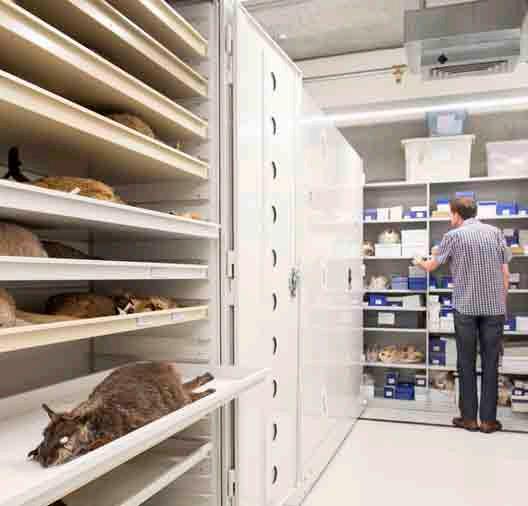
3 minute read
Leaner and greener Balancing collection care with environmental costs by Colin MacGregor
leaner and
leaner and GREENER
Opposite
Dr Mark Eldridge at work in the mammals collection area of the Museum’s Research & Collections building. Photo by Stuart Humphreys.
CLIMATE CONTROL WITHIN THE MUSEUM IS ESSENTIAL FOR COLLECTION CARE AND VISITOR COMFORT, BUT NEW APPROACHES ARE REDUCING ENVIRONMENTAL IMPACT AND ENERGY COSTS, SAYS MATERIALS CONSERVATION MANAGER COLIN MACGREGOR.
Ensuring the Museum’s collections remain in good condition deep into the future is one of our key goals. Climate control in storage areas is essential, but the environmental impact, and rising cost, of energy has led us to rethink the way we manage our airconditioning systems – with promising results. The environmental efficiency of a building starts at the design stage, and the Museum’s Collections & Research Building, completed in 2008, adopted a more passive approach to climate control, with an outer glass ‘skin’ to trap hot air, and collection storage areas located in the cooler heart of the building. Humidity in particular can damage collections by encouraging mould, corrosion and increased pest activity, but extracting moisture from the air, especially in Sydney’s humid climate, is the most energy-hungry part of airconditioning. Until recently, international standards for collection care in museums and galleries mandated a relative humidity range of between 45 and 55 per cent, but running air-conditioning 24/7 to achieve this narrow range is extremely expensive.
SAVINGS
For the past two years we have trialled shutting down the airconditioning overnight and at weekends. We’ve found that a solid, well-sealed building can maintain stable conditions for long periods without constant airconditioning or compromising collection care. As a safety net, the computer-controlled airconditioners automatically restart should conditions start to drift too far in response to changes in the weather. So far, these measures have resulted in energy savings of 1.6 MWh per day for the Museum, which is equivalent to taking 53 Sydney houses off the grid. Most of the energy for airconditioning is used to process unconditioned air from outside. Our Building Services team is currently installing a new type of dehumidifier, allowing some moisture to be removed from incoming air before it reaches the airconditioning plant, further reducing energy consumption. Additionally, the fitting of carbon dioxide sensors in the galleries allows the building management computer to control the amount of outside air brought in by the system. On quieter days, less outside air is required to maintain the balance between oxygen and carbon dioxide.
PEOPLE POWER
While very high or low humidity levels can damage collections, temperature is less critical. A mid-range and stable humidity level is ideal for collection care, but temperature standards are usually dictated more by human comfort and can be allowed to drift somewhat. This was brought home to me while visiting the National Museum of Science in Japan shortly after the 2011 earthquake and tsunami that killed tens of thousands and crippled the country’s energy supply. In the hot summer weather, notices informed the public that the airconditioning was set at 28°C to help reduce energy usage. Given the changing economic and environmental landscape in which we live, is the enormous energy cost of maintaining precise conditions through summer and winter acceptable? The Director of the Tate Gallery in London, Sir Nicholas Serota, has stated that visitors to the Tate may have to dress appropriately for a varying climate in future as temperatures are allowed to drift in order to balance collection care with the energetic and economic costs of environmental control. In a warming climate, perhaps we’ll all need to develop greater tolerance of higher temperatures. The lessons we’ve learned at the Museum could readily be applied to other situations, such as office buildings and even homes. Together we can make a difference. As the saying goes: think global and act local!
COLIN MACGREGOR MANAGER, MATERIALS CONSERVATION










